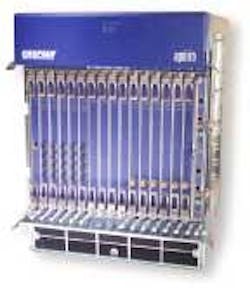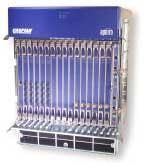Caspian's flow-based router
Though in stealth mode for nearly four years, Caspian Networks (San Jose, CA) has nevertheless attracted a great deal of attention, particularly from venture capitalists who have invested more than a quarter-billion dollars in the company to date. Caspian recently unveiled its long-awaited Apeiro flow-based router to all the expected fanfare—minus one critical element: The company does not yet have publicly announced customers.
"What that tells you is that (a) it's very, very difficult to penetrate this market because you have two very strong incumbents in Cisco and Juniper and (b) there's a good possibility that this router doesn't do anything so radically different or radically better than its competitors," contends Mark Bieberich, Communications Network Infrastructure senior analyst with the Yankee Group (Boston). The Apeiro router boasts several key capabilities, but whether these capabilities are measurably better than incumbent vendor offerings remains to be seen.As a native IP platform, the Apeiro router achieves the scalability and performance of IP, claims the company, while delivering the very deterministic quality of service (QoS) of ATM, thanks to its patented flow-based technology. Unlike traditional routers that forward each packet individually, Caspian's router processes groups or flows of related packets. When a packet comes in, the Apeiro performs a standard IP routing lookup and forwards the packet as a traditional router would, but it then takes that routing information and writes it back into memory, along with such information as the acceptable delay of the packet, delay variation, bandwidth requirements, and the priority of that particular user or application. The router then switches subsequent packets in the flow based on this stored information.
"We studied this on MCI's backbone network," explains Faizel Lakhani, Caspian's vice marketing president, "and we found that on a 10-Gbit/sec pipe, vendors need to set up about 150,000 flows per second. At Caspian, we can do between 500,000 and one million flows per second per 10 Gbits/sec. People look at this and say, 'If you can do that many, then we can now do individual flows by individual applications and provide very premium, deterministic-type services.'"
Reliability is also achieved via the router's supercomputer-like distributed architecture. Each single-shelf Apeiro router accommodates four fabric cards, two shelf supervisor cards, and 12 line cards that support 10-Gbit/sec processing. Each line card acts as a fully functional router, able to perform classification, flow-hashing, policing, queuing, shaping, and scheduling without the help of a centralized management server.
Caspian "may very well have the lead" in intelligent routing, notes Bieberich, but that is only one criterion out of many, he cautions. While the company has its sights set on a piece of the high-performance IP systems market faces tough competition from incumbent powerhouses Cisco Systems and Juniper Networks as well as fellow startup Procket Networks. Alcatel has also thrown its hat into the core-router ring and may prove to be formidable competition.
To help jumpstart Apeiro router deployments, the company has initiated what it calls the Caspian CORE (Capex/Opex Reduction Enhancement) trade-in program, which allows carriers to trade their existing routers and ATM switches for credit toward the flow-based router. That's a nice added incentive, but will it be enough to unseat the incumbents?
"You can build a better router these days," says Bieberich, "but to actually sell that router is a very, very difficult proposition."

